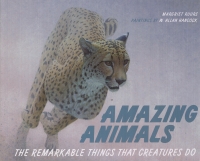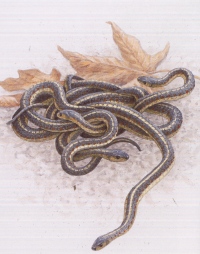| ________________
CM . . . . Volume XVII Number 39. . . .June 10, 2011. 
 |
Amazing Animals: The Remarkable Things That Creatures Do.
Margriet Ruurs. Paintings by W. Allan Hancock.
Toronto, ON: Tundra Books, 2011.
32 pp., hardcover, $19.99.
ISBN 978-0-88776-973-3.
Subject Heading:
Animal behavior-Juvenile literature.
Grades 2-4 / Ages 7-9.
Review by Saeyong Kim.
**/4
|
| |
|

excerpt:
The different ways that animals communicate send out important messages to their own species and to others. A wagging tail, sniffing and baring teeth, or birdsong are just some of the ways animals communicate.” (p.12)
Salmon are born in freshwater creeks, but soon after, they swim out to the salty sea, where they live for seven years. After that, salmon make their way back, across thousands of miles, to spawn in the very same creek that they were born in.”(p.18)
Amazing Animals, a collection of facts about different animals across the globe, is aimed towards stimulating readers’ interest in each featured animal and encouraging them to learn more on their own. The information is divided into eight categories, such as reproduction, communication, diet and homebuilding. Each category has illustrations of five to seven animals, with a short paragraph of three or four sentences alongside the picture telling the reader about an aspect of the animal relating to the title category. For example, in the category “Reproduction”, one can see a picture of emperor penguins carrying their eggs on the tops of their feet, and the reader will learn that the penguin females leave their eggs with the males while they journey to the sea to find food. There is a brief glossary at the end of the book, giving definitions of unfamiliar terms.
The illustrations, acrylic on masonite, display the subject animal with great realism, sometimes within its environment and sometimes with no background at all. The paintings are vivid and lifelike, but perhaps because of the sheer number of animals in the book, there is sometimes less of a visual impact than there could have been. For example, a gorgeous picture of a blue whale, the largest mammal, is crammed into only a third of a page and ends up looking rather like a postcard. The full-page illustrations of orcas and the tuatara, though, are breathtaking.
 Due to the broad scope of the book, readers get only a very brief introduction to the animals, how they live and what they look like, but the great variety of animals is appealing in itself and interested readers may wish to look up more about these animals on their own. Due to the broad scope of the book, readers get only a very brief introduction to the animals, how they live and what they look like, but the great variety of animals is appealing in itself and interested readers may wish to look up more about these animals on their own.
Recommended.
Saeyong Kim is studying for a Master of Arts in Children’s Literature at the University of British Columbia, BC.

To comment on this title or this review, send mail to
cm@umanitoba.ca.
Copyright © the Manitoba Library Association. Reproduction for personal use is permitted only if this copyright notice is maintained. Any other reproduction is prohibited without permission.
NEXT REVIEW |
TABLE OF CONTENTS FOR THIS ISSUE- June 10, 2011.
AUTHORS |
TITLES |
MEDIA REVIEWS |
PROFILES |
BACK ISSUES |
SEARCH |
CMARCHIVE |
HOME |

 Due to the broad scope of the book, readers get only a very brief introduction to the animals, how they live and what they look like, but the great variety of animals is appealing in itself and interested readers may wish to look up more about these animals on their own.
Due to the broad scope of the book, readers get only a very brief introduction to the animals, how they live and what they look like, but the great variety of animals is appealing in itself and interested readers may wish to look up more about these animals on their own.